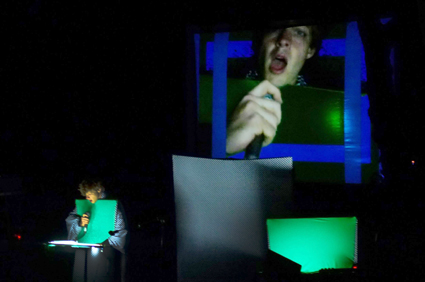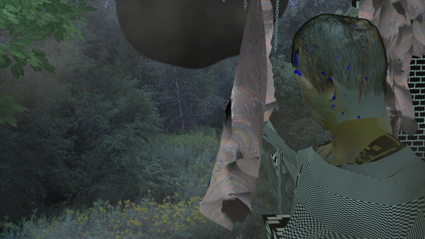70s dystopia in 2013 via 80s & 90s tv
danni zuvela: interview, peter burr, audiovisual performer

Peter Burr, Special Effect, courtesy the artist
NEW YORK-BASED ARTIST PETER BURR IS FAMED FOR HIS WILDLY CARNIVAL-ESQUE PERFORMANCES AS HALF OF POPULAR ‘TRICK-OR-TREAT-TRANCE’ DIGITAL MUSIC/ANIMATION DUO HOOLIGANSHIP AND FOR CO-FOUNDING THE UNDERGROUND ANIMATION COLLECTIVE CARTUNE XPREZ.
Burr’s new work, Special Effect sees him branch out into solo audiovisual performance in the form of a live experimental television program, in which Burr presides over a succession of increasingly bizarre digital images, replete with the interruptive agenda of commercial breaks. Drawing on a surprising wellspring for its inspiration, Special Effect features Burr’s typically highly physical performance bent to more experimental ends, collaged into the action via green screen, as the master of a strange ceremony.
Tell me about the genesis for Special Effect—where did it come from?
I have a habit of incessantly drawing, somewhat aimlessly, in between large-scale projects. It calms me down. I’ve been in this rhythm for years. Last spring, after finishing my project Green | Red, I had just rewatched Stalker (Andrei Tarkovsky’s legendary 1979 sci-fi film) and found myself making drawings based on paused frames of the film. The specifics of the movie weren’t in those images, but some of the mood contours were—the figures, choreography and architecture. Something about this really gelled…and so I decided to explore them in four dimensions. Also, around this time, I was talking with a bunch of other video artists and animators and noticed there was a thread here that these artists were also inspired by—there’s been a serious Stalker wavelength growing fresh over the last few years. I found lots of personal resonances with this film…and so did others. So that’s really where the project comes from, how it was birthed.
The next stage was shooting in some abandoned sites?
Yes, I met up with a group of friends who were keen on exploring ruined/abandoned sites around New York. I started tagging along with them, borrowing friends’ cameras and shooting landscape footage—this eventually was integrated into the animated segments of Special Effect, in various forms. It turned into this self-propelling journey into the armpits of America, delving into our zones of exclusion to find my own story somewhere in the Stalker script.
Do you remember the first time you saw Stalker?
I first heard about the film as a resident artist at the Macdowell colony, the oldest artist colony in the States, in New Hampshire. I used to take pathless walks through the winter woods there and once a friend accompanied me and he was like, “This is just like being in Stalker.” At the time I hadn’t seen it but he meant the stillness and the thin trees and how you could hear your footsteps in the thick carpet of leaves left on the ground. His description of the film mesmerised me, but I never got around to watching it until about a year later when I was touring around Europe. I had a copy of it on my laptop and during an overnight trip from London to Antwerp I thought, “Let’s fire it up!” I remember getting into the station and having time to kill before I could find my host there and feeling grateful there were so many hours left in the film. It felt like this dreamy, endless drift through parallel worlds, perfect for my transient, half-awake state. Only my world was a bit drier—compared to the endless puddles and rain and splashing that is like a running joke through Stalker.

Peter Burr, Special Effect, courtesy the artist
The audience for Special Effect can see how you’ve responded to those bleak Tarkovskyan pans—but yours are really heavily effected. What are you trying to do with the motion graphics in this work?
I think a lot about transforming the thumbprint of images. How can this be done to icons of pop culture that, untransformed, propel us into nostalgic mental loops? How can I strip off the marks of specific software that read as emblems of their design? The signature ‘look’ of software is something I think about a lot. Each program wants to announce itself. But there are a million different paths in there to smear or shift the markings, to carve out something unique with the same tools that everyone’s using. I’m not into speaking with the voice of a generation or being the voice of a particular piece of software. I think I really work adversely to that.
With this whole project, there was an element of dealing with iconography, of Stalker. Dealing with tradition. But at the end of the day it’s not replicating. I’m trying to invent something new from it. Something that actually feels like its own thing. I wanted to work with some of the elements I admired from the film, like the Tarkovskyan pans, but let them be transformed. I was aiming to create a new feeling that’s rooted in my own feeling of the world just as much as it is rooted in this source. I guess…in creating a project that’s about ripping off the greatest film ever, I feel like it’s also important for me to push away from it.
Like you push away from demo-ing ‘high’ technology with the software thumbprint?
Yeah, I’m not interested in a display of the newest technology. Special Effect shares the load around—it’s a pretty tangled knot of high-end and low-end software. To me it’s important to obscure those distinctions in the work. It’s not about the newest, coolest thing. I like using crappy free technology too. Or if I’m using familiar software then it’s about misusing it and using it in weird combinations and configurations, ways that aren’t emblematic when you think about the software.
Is that why you’re interested in incorporating the live performance element?
It adds an angle of chaos. With this kind of motion graphics work it is so easy to get stuck in the structure of the computer process. I write a script, draw a storyboard, then execute the blueprints. But straightforward in this way, it lacks something. Adding layers of liveness to it all makes it feel more honest. There’s the effect of real bodies, this risk of everything falling apart, the lasers threatening to blind you…! It makes you watch it all very differently than you’d watch The Hobbit (3D or no-3D).
I know you watched a lot of cartoons as a child and that drew you into the world of animation; that sensibility permeates Cartune Xprez but is pared back, thinned out in Special Effect. What’s the relationship with TV in this work? Why structure it as a TV program?
With television, my references are all very different today than they were a decade ago. I don’t think I’m alone with this. I haven’t watched ‘television’ in years—the internet and my own art practice replaced that for me. This definitely creates space for me to play with the idea of television. It’s almost an imaginary object for me now. We’ve had this shift away from the fascist architecture of media—TV programming—into user-controlled, user-generated media. There’s no tolerance of boredom now and that really interests me. There’s certainly a confrontation with boredom in the show—it deals with Stalker, after all! I guess I’m trying to reconcile the slow, quiet, maybe confusing drifts with really short-attention-sapan-overload segments.
Of course, I grew up watching over eight hours of TV a day until I went off to college, so there’s also a very real imprint of its effects on my imagination. I don’t know exactly why, but it just feels intuitive to make fractured, commercial-interrupted, channel-surfed work. My attention span is all out of whack.
I guess that’s informed my way of approaching things now. Special Effect isn’t ‘about TV’—I don’t even know what TV is any more. Like I said, it’s an imaginary system for me. Because I don’t watch TV but remember it—and especially commercial breaks—I’m like, “I haven’t seen one in a while, so let’s have one, and let’s make it fun!.” So it’s kind of like a late 70s vision of a dystopian future, looked back on through the lens of 80s and 90s TV, from the position of early 2013. If that makes sense.
Peter Burr, Special Effect, Brisbane, Melbourne, Meredith Music Festival, Adelaide, Dec 5-10, 2012; http://otherfilm.org/peter-burr-cartune-xprez/; Museum of Moving Image, NY, 18 Jan 18, 2013; www.peterburr.org
RealTime issue #113 Feb-March 2013 pg. 20






